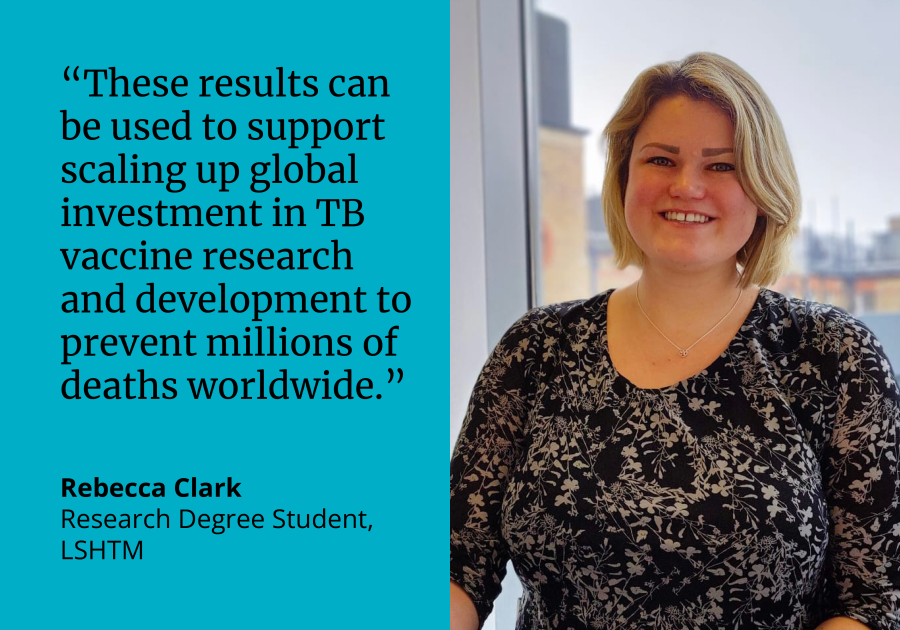
Tuberculosis (TB) vaccination could be highly impactful and cost-effective in most low- and middle-income countries (LMICs), according to a new modelling study published in PLoS Medicine.
TB vaccination was found to be cost-effective in 70% of 105 LMICs included in the study, with an adolescent/adult TB vaccine producing US $283–474 billion in health and economic benefits by 2050. Greater benefits would occur in LMICs with a higher TB burden.
The study team included researchers at the TB Modelling Group, the Global Health Economics Centre (GHECO) and the Centre for Mathematical Modelling of Infectious Diseases (CMMID) at the London School of Hygiene & Tropical Medicine (LSHTM); Harvard University; the World Health Organization (WHO); and the International AIDS Vaccine Initiative (IAVI). The team estimated a range of possible outcomes following the introduction of a new vaccine for TB affected countries, comparing this to a “no-new-vaccine” scenario.
The only currently licensed TB vaccine is the Bacillus Calmette-Guérin vaccine (BCG), which is over 100 years old. It is administered neonatally in high incidence countries. BCG is effective at preventing childhood TB but has shown variable protection for adolescents and adults, the age group with the highest burden of TB disease. A new vaccine that is effective at preventing disease in adolescents and adults is urgently needed.
The researchers projected changes in healthcare utilisation, health outcomes and healthcare costs to estimate the health and economic impact a new TB vaccine could have using mathematical and economic models. The outcomes were estimated for 105 LMICs representing 93% of the global TB burden, from 2028 to 2050. 27 of the countries included have a high burden of TB. The “no-new-vaccine” baseline was based on current TB interventions continuing at current levels.
Rebecca Clark, from LSHTM’s TB Modelling Group, who carried out the transmission modelling for this study said: “I hope these results will be used to support scaling up global investment in TB vaccine research and development, so we can prevent millions of TB deaths worldwide.”
Two vaccine profiles were used to estimate the health and economic impacts: an infant “pre-infection” preventative vaccine targeting neonates (newborns <4 weeks old) and an adolescent or adult “pre- and post-infection” preventative vaccine. Both vaccines were assumed to offer 10-years of protection and prevent disease.
For both vaccine strategies, vaccination was more likely to be cost-effective in lower middle-income countries, compared to low-income and upper middle-income countries.
From a health-system perspective, including costs of vaccine introduction, the researchers found that an infant TB vaccination would be cost-effective compared to the “no-new-vaccine” scenario in 45% of the 105 LMICs in the study, including 89% of the 27 countries with high-TB burden. In contrast, the adolescent/adult vaccine would be cost-effective in 61% of the 105 countries and 100% of those with a high-TB burden. Neither vaccine strategy was found to be cost-saving in any country.
From a societal perspective, including all costs from the health-system as well as productivity gains and averted patient costs, the infant vaccine would be cost-effective in 53% of the 105 countries, including all with a high burden of TB. The infant vaccine would also be cost-saving in 44% of countries. The adolescent/adult vaccine would be cost-effective in 70% of the 105 countries, including all with high-TB burden. It would be cost-saving in 55% of countries.
The study found that there was greater and more rapid impact from an adolescent/adult vaccine compared to an infant vaccine over the 2028 to 2050 period. The infant vaccine costs were projected to increase smoothly each year while the adolescent/adult vaccine required major upfront investment and a 5-year roll-out campaign. When considering the monetised value of the health gains offered by TB vaccination, the adolescent/adult vaccine strategy could produce up to US $474 billion in health and economic benefits by 2050, demonstrating a significant return on investment.
The health gains from vaccination were calculated using Disability-Adjusted Life-Years (DALYs) averted. DALYs are used by WHO to measure the global burden of disease and include years of life lost due to TB and years lived with disability due to TB.
TB is a leading cause of infectious disease death globally. It caused 1.5 million deaths in 2020, despite being both preventable and curable. The development of new, safe, effective and affordable TB vaccines is critical to achieve the WHO TB targets. The results of this study can be used to inform future decision making on the investment, development, and implementation of new TB vaccines.
Publication
Portnoy et al. (2023). The cost and cost-effectiveness of novel tuberculosis vaccines in low- and middle-income countries: A modelling study. PLoS Medicine. DOI: https://doi.org/10.1371/journal.pmed.1004155
Our postgraduate taught courses provide health practitioners, clinicians, policy-makers, scientists and recent graduates with a world-class qualification in public and global health.
If you are coming to LSHTM to study a distance learning programme (PG Cert, PG Dip, MSc or individual modules) starting in 2024, you may be eligible for a 5% discount on your tuition fees.
These fee reduction schemes are available for a limited time only.
